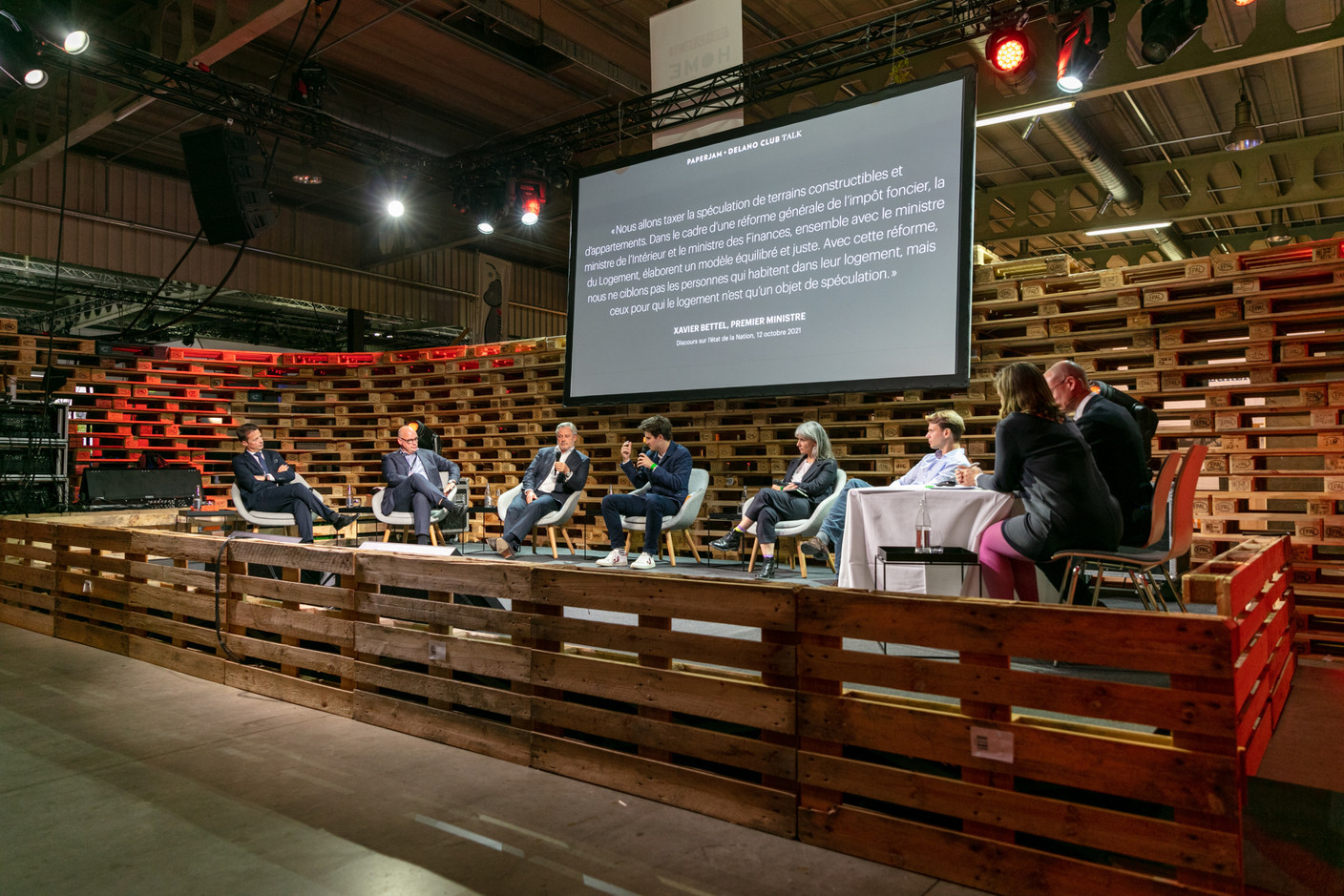“We can beat this housing crisis together,” said lawyer and activist Max Leners, also a member of LSAP, at the round table "Housing crisis: who's holding back" organised by the Paperjam + Delano Club on Wednesday evening.
The round table brought together six experts and professionals from the sector: Leners, but also Sara Noel Costa de Araujo (architect and manager of the SNCDA studio), Olivier Bastin (CEO of Immobel Luxembourg), Jacques Brauch (general manager of Soludec), Marc Giorgetti (manager of Félix Giorgetti), and Antoine Paccoud (research scientist at the Luxembourg Institute of Socio-Economic Research).
300 people attended the event, which sought to propose concrete solutions for the near future, including several political representatives.
Increasing the scope of PAGs?
Moderated by the editor-in-chief of Paperjam magazine, Thierry Raizer, and the editor-in-chief of Paperjam Architecture + Real Estate, Céline Coubray, this round table resulted in 38 concrete proposals, which will be sent to each political party represented in the Chamber of Deputies.
While “everyone agrees on creating housing”, as Giorgetti noted, it is more difficult to find a consensus on the means to achieve this.
Everyone around the table agreed that the housing crisis is due to a mismatch between supply and demand. To this end, a first solution is being explored: increasing the scope of the general development plans (PAG). “This would act directly on supply and have an immediate effect,” said Bastin. But the fact is that “many municipalities do not do this,” said Brauch.
Densify
Leners, for his part, pointed out that “it is easy to talk about increasing the perimeter”, but that this represents a risk for the environment. It would not be a solution, since “the environmental crisis is more important than the housing crisis.”
Densification is an answer to the environmental crisis.
Bastin offered another proposal: “Densification is an answer to the environmental crisis,” he said. “If we move towards taller buildings, then less surface area is used. So height is good for the environment,” he said.
For Antoine Paccoud, increasing the perimeter would not be a priority: “We have a large land reserve, so the problem is not the surface area, but the mobilisation of this. Before extending the perimeters of the areas, I would like us to see why it cannot be mobilised.”
Activating the fiscal lever
From this, the discussion moved on to taxation. With the value of land rising by 15% each year and almost no property tax in the country, “there is no better investment than a building plot,” said Paccoud. To encourage owners (72.5% of whom are individuals) to sell or build, tax leverage seems the best way.
There is no better investment than a building plot.
“I don’t think we should punish people with taxes, especially since a property tax will only lead to very few people selling,” said Brauch.
“I know it’s not very popular to talk about taxes,” said Leners. “But how can land retention have a cost if not through taxation?”
But, if such a tax is introduced, there is a risk that the owner, won’t obtain planning permits for years to come, said Bastin.
Administrative mille-feuille
If there is one thing that annoys people in Luxembourg, it is the length of the procedures. The “administrative mille-feuille” between the various players involved in the procedure is such that obtaining a PAP [special development plan, editor’s note] can take not three to four years, but rather 13 to 14 years, said Brauch. “All these people are well-intentioned, but between the ministry, the municipality and, for example, the water authority, which do not have the same opinions, when you have finished with one, you contradict the other, and then you have to start all over again,” he said.
When you're done with one, you contradict the other, and then you have to start all over again.
“Elon Musk has fewer procedures to go to the Moon than we do to build housing estates,” said Giorgetti, adding that procedures must be simplified but simply doubts “the will of the communes to have new housing and to welcome people.”
“The mayor is moving towards what the inhabitants of his municipality want,” said Brauch, who believes that they limit the number of housing units because “Luxembourgers want to stay among themselves” and want housing to be created, “but somewhere else, not on their premises.”
Elon Musk has fewer procedures for going to the Moon than we do for building housing estates.
Helping the mayors
“The mind of a mayor is only as big as their own municipality,” said Leners, for whom the decision to build should not be taken by the municipal council, but at national level. “We have the tools to do it, politicians need to have the courage--talking to 102 mayors is more difficult.”
“The mayors are not professionals in the sector, we must help them, we must not leave them alone” when it comes to building decisions, said Sara Noel Costa de Araujo, for whom it is necessary to “professionalise the decision-making process for building in cities.” Other countries, like Belgium, already have advisory bodies in place, she said.
The mind of a mayor is only as big as their own municipality.
For Leners, one solution would be to reverse the burden of proof in the procedure: since it is the local council that decides on building land, it should be up to them to prove that a plot of land is not suitable for building, rather than leaving it to the developer to prove that it is.
Bringing the actors together
Many other issues were discussed on Wednesday evening, including the expansion of affordable housing, the adaptation of housing, especially to smaller sizes. Or even, rather than increasing supply, reducing demand, questioning Luxembourg’s economic model, which relies on demographic growth.
We need to professionalise the decision-making process for building in cities.
However, in order to have a chance of implementing all these solutions, one prerequisite seemed to be essential and to achieve consensus: to get together. Bringing all the players around the table--those from the public and private sectors, architects and researchers--to discuss in all transparency the means of overcoming a housing crisis that is far from finished making headlines.
The 38 proposals:
1. Enlarge the building perimeters
2. Accelerate procedures
3. Change the burden of proof
4. Making PAGs more readable
5. Review the biopoint system
6. Reduce the number of communes
7. Increase the number of staff in charge of these issues
8. Look into Belgium’s “Baumeister” system
9. Review ministerial competences
10. Create a one-stop shop
11. Pass an anti-housing crisis law
12. Accelerate construction on public land
13. Priority to public-private partnerships
14. Increase density and height
15. A national land use plan
16. Ongoing housing monitoring
17. Do not forget about disposal sites for soil and waste from construction sites
18. A tax incentive to sell to the state
19. Increase affordable rentals
20. Create specialised funds for affordable housing
21. Affordable properties for sale and for rent
22. Institutionalise renting
23. Priority to homebuyers
24. Reforming registration
25. Tax unused land
26. Review accelerated depreciation
27. Review registration and recording fees
28. Reduce notary fees
29. Adjust "buy to let" loans
30. A Marshall Plan for infrastructure
31. Designing new cities
32. Design office buildings with front doors as they are in private homes
33. Give a percentage for project innovation and make regulations more flexible
34. Consider temporary housing
35. Adapting legislation to temporary housing
36. Putting architecture back into culture or discourse
37. Limiting the weight of foreign actors
38. Reduce demand
This story was first published in French on . It has been translated and edited for Delano.












